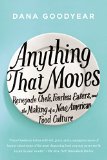Summary | Excerpt | Reviews | Beyond the Book | Readalikes | Genres & Themes | Author Bio
Renegade Chefs, Fearless Eaters, and the Making of a New American Food Culture

Critics' Opinion:
Readers' Opinion:
First Published:
Nov 2013, 272 pages
Paperback:
Nov 2014, 272 pages
 Book Reviewed by:
Book Reviewed by:
Poornima Apte
Buy This Book
Brian Vidor built his businesses around the thrill of eating the forbidden: tiny
insects downstairs, massive endangered species upstairs; one place representing rapacious,
selfish, greedy devouring of all the world's creatures, the other broad-minded, virtuous,
global humanism; one theoretically sustainable, one likely not; both challenging notions
of what is appropriate food. Vidor's lawyer entered a not guilty plea for Typhoon
Restaurant, Inc., too. After leaving the courtroom, he summed up his client's position
and, as far as I could tell, the attitudes of the adventurous foodies who ate there and
distanced themselves when the dark side of their thrill-seeking was exposed. "He owned the
restaurant, but he's a Caucasian, he's a fun-loving guy — he wasn't involved day to
day."
In early 2013, Tesco, the British supermarket chain, made a startling revelation: some
of its frozen beef patties contained horsemeat, one sample as much as twenty-nine per
cent. Then Burger King, which used the same Irish supplier (who put the blame on its
supplier, in Poland), admitted that its meat was potentially contaminated, too. A
British food manufacturer disclosed that its beef lasagna was purely horse. Ikea pulled
its meatballs — horse — from locations across Europe. CBC News reported that the horsemeat
scandal had stirred the competitive instincts of Canadian foodies, many of whom were
rushing to try it. For Americans who worried that something similar might happen here, it was hard to
say what was more disconcerting, the idea that you wouldn't be able to taste the horse, or
that you would.
Horse meat is red, bloody, unmarbled, and is said to be reminiscent of venison
(venison, apparently, is the chicken of the alt-meat world). It takes a lot of grass to
make a little bit of horse; given a choice, people have preferred to use them as work
animals, transportation, and instruments of war. In the first millennium, the Catholic
Church, threatened by the stubborn pagan habit of ritual horse-eating—it was tied to Odin
worship in Germany and Northern Europe—took the unusual step of banning it. Mostly, the
ban was successful; only Iceland, which made exemption a condition of conversion, kept at
it.
Parisians discovered horse meat the hard way, as a meat of last resort during the
Revolution. By the mid-nineteenth century, just in time for the Siege of Paris, when it
came in handy again, intellectuals were promoting it as a cheap, nutritious, and tasty
solution to the problem of hunger. The nineteenth-century French zoologist Isidore
Geoffroy Saint-Hilaire, who advocated for chevaline on practical and culinary
grounds, wrote that its flavor was comparable to beef and recommended it by saying that
"it has been sold in restaurants, even in the best, as venison, and without the customers
ever suspecting the fraud or complaining of it."
"Horse-flesh pie, too, eaten cold, is a dainty now at Berlin and Toulouse, and boiled
horse, rechauffé, has usurped the place of ragouts and secondary dishes!" Peter
Lund Simmonds wrote in "The Curiosities of Food," in 1859. But trusty, tin-earred Anglo-
Saxon—"horse-flesh pie"—was not the way to introduce the delicacy that, Simmonds said, was
"at the present the rage" in the dining clubs and salons. The Englishmen of the Society
for the Propagation of Horse Flesh as an Article of Food hired French chefs to prepare
banquets of chevaline. Previously, the English had known chevaline by the
name "cat food."
In 1979, another intellectual, Calvin W. Schwabe, the "father of veterinary
epidemiology," published "Unmentionable Cuisine," which he described as "a practical guide
to help us and our children prepare for the not too distant day when the world's growing
food–population problem presses closer upon us and our overly restrictive eating habits
become less tolerable." The taste for horse, he wrote, was "superficially latent" in many
Americans. Case in point: a horsemeat shop in Westbrook, Connecticut, that opened in the early seventies, during a period of high beef prices, and was hugely successful in spite of mounted protestors. ("I'll sell it as long as it moves," the
proprietor told a reporter amid brisk sales on opening day.) Schwabe also provided a
recipe for meatloaf—three parts horse to one part pork—he and his wife made often during
his years in vet school.
Excerpted from Anything That Moves by Dana Goodyear. Copyright © 2013 by Dana Goodyear. Excerpted by permission of Riverhead Books. All rights reserved. No part of this excerpt may be reproduced or reprinted without permission in writing from the publisher.





The Flower Sisters
by Michelle Collins Anderson
From the new Fannie Flagg of the Ozarks, a richly-woven story of family, forgiveness, and reinvention.

The House on Biscayne Bay
by Chanel Cleeton
As death stalks a gothic mansion in Miami, the lives of two women intertwine as the past and present collide.

The Funeral Cryer by Wenyan Lu
Debut novelist Wenyan Lu brings us this witty yet profound story about one woman's midlife reawakening in contemporary rural China.
Your guide toexceptional books
BookBrowse seeks out and recommends the best in contemporary fiction and nonfiction—books that not only engage and entertain but also deepen our understanding of ourselves and the world around us.